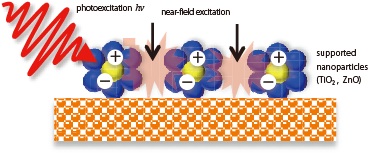Photo-induced electron dynamics in nanostructures and development of quantum devices with optical and electronic functionality
Interviewee:
|
Interviewer:
|
| Associate Professor, Institute for Molecular Science, National Institutes of Natural Sciences |
CMSI Molecular Science |
What type of research are you conducting for this Special Support Topic?
Electronic devices use the movement of electrons, but we can develop new devices by utilizing light functions in addition to such electronic functions. Our objective is the theoretical design, from a basic physical standpoint, of quantum devices with optical and electronic functionality that are smaller and faster, consume less energy, and have a greater ability to withstand external influences. Our highest priority is to propose design guidelines, from a computational science perspective, that can aid in the development of next-generation devices for the propagation of electromagnetic field energy (wave guides), as well as quantum data transfer devices, solar cells and photocatalysts efficiently converting photovoltaic energy into electricity, chemical energy and so on.
Why do you need to use the K computer to conduct theoretical design?
The functionality of the optical and electronic next-generation quantum devices considered in our research is governed by the complex interactions and motion of electrons and light occurring in extremely tiny domains on the order of a few to a dozen or more nanometers. To complement the experimentation and development research whose goal is device design, we will also conduct device design on the basis of theoretical calculations, and we plan to make extensive use of the findings in actual device design. It will be extremely important to pursue device development from the standpoint of both theory and experiment.
The behavior of light and electrons occurring in nanometer-size devices can be expressed in equations based on quantum mechanics. Solving these equations in a manner that envisions an actual device will require calculations on an extremely large scale. Using approximately 200,000 cores, or about one-third of the total resources of the K computer, our group has completed a program efficiently describing the behavior of light and electrons.
Can you tell us about the future prospects for research in this area?
Research areas for the development of next-generation devices vary widely, from basic research to application development, and for this reason it is vitally important to clearly identify the issues to be resolved. We plan to use the K computer to its maximum potential to gain an understanding of the mechanisms of device operation from a basic academic standpoint and formulate theoretical predictions for the discovery of new functions and so on, in order to establish a nano-optical response theory that can serve as a guiding principle for device design.
|
|
| Theoretical design for a light energy conversion nanodevice with broadband, high-efficiency visible light response characteristics. Clear couplings of electrons and electromagnetic fields are produced through near-field light interaction occurring in orderly rows of nanoparticles placed on the platinum (Pt) surface. |




